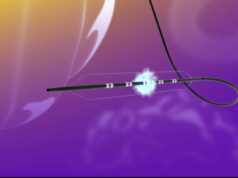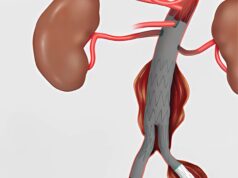
A study published in the Journal of Endovascular Therapy suggests that carbon dioxide flushing may be a solution for the “potentially underappreciated” problem of arterial air embolism in aortic endografting.
Thoracic endovascular repair (TEVAR) “is now the treatment of choice for thoracic aortic dissection,” write Tilo Kölbel, University Hospital Hamburg Eppendorf, Hamburg, Germany, and colleagues, who authored the study. However, TEVAR procedures still carry a significant risk of stroke, “which has been reported to be 2–6% % and up to 10% in some studies,” and as high as 16% in more complex endovascular procedures of aortic arch pathologies, the authors note.
Stroke during TEVAR is generally thought to be embolisation of thrombotic and atherosclerotic material from the vessel wall caused by wire manipulation and apposition of the stent graft on the aortic wall during deployment or repositioning. However, Kölbel and colleagues write that “This hypothesis has, however, never been supported by studies.”
“Another potential source,” they suggest, “is air embolism following release of trapped air from the stent-graft during deployment,” which “has been identified as the source of neurological deficits during coronary artery bypass grafting, endoscopy, and interventional procedures.”
Because they are packed in gas-permeable packaging under room air conditions, the tubular stent grafts used in TEVAR are delivered filled with room air. Though this is typically removed prior to implantation by flushing the sheath in which the assembly is loaded with an isotonic solution. However, “The degree to which the air is removed by this saline flushing technique and the volume of air released into the vasculature are not known yet,” write the authors.
Kölbel et al decided to use carbon dioxide as it “has a much higher solubility in blood compared with room air,” and “because it resolves faster in blood than the nitrogen-rich room air, thus potentially causing less harm.”
To remove room air, thoracic stent grafts were preoperatively flushed for two minutes with carbon dioxide from a cylinder connected to the flushing chamber of the captor valves of custom-made endografts. This was followed by the standard saline flush. Thirty-six patients undergoing thoracic endovascular aortic repairs (TEVAR) involving the ascending aorta and the aortic arch received carbon dioxide-flushed endografts, with one patient with a highly calcified arch experiencing a minor stroke. Thirty-day survival was 97%; a multi-morbid patient died postoperatively of multi-organ failure despite a successful branched TEVAR procedure.
“Trapped air in stent grafts may play a crucial role in the stroke rate during TEVAR, although there are no studies that investigate air embolism as a source of this complication,” the authors conclude. “Nonetheless, the release of trapped air needs to be controlled, especially when deploying stent grafts close to coronary and supra-aortic arteries. Carbon dioxide flushing of stent grafts offers a feasible and low-cost method to reduce the amount of room air prior to deployment.”












